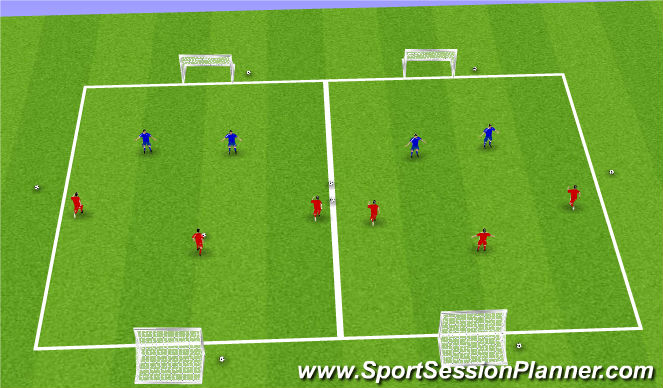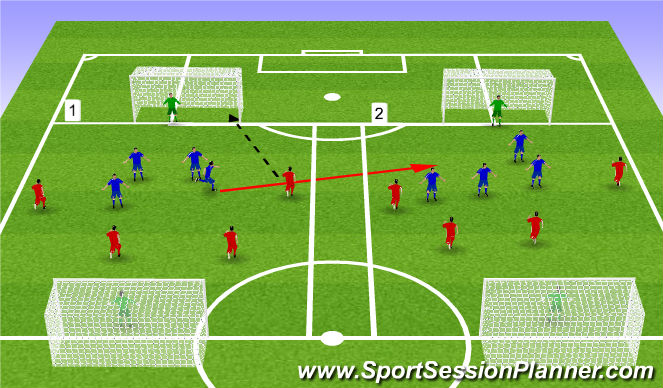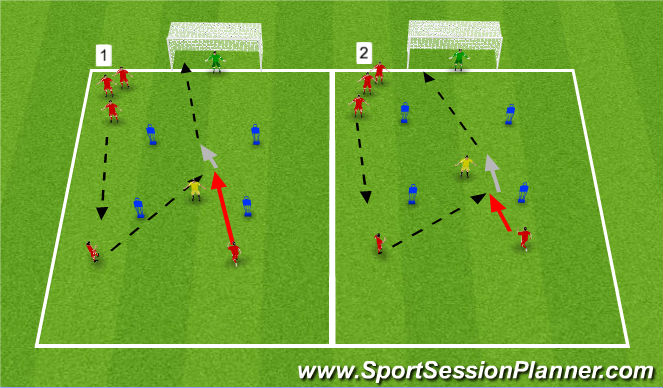Football/Soccer Session (Moderate): Counter Attacking & Emergency Defending U8-U11
Profile Summary

| Name: | Christopher Ruiz |
|---|---|
| City: | Lutz |
| Country: | United States of America |
| Membership: | Adult Member |
| Sport: | Football/Soccer |
Description
PRINCIPLES OF PLAY
• Speed of attack in possession
• Delaying, denying and dictating out of possession
PART 1: UNOPPOSED TECHNICAL PRACTICE
• This is a repetitive finishing practice designed to develop players’ timing of forward runs, decisionmaking, detail of forward pass and finishing off both feet.
• The practice requires a minimum of six players including a goalkeeper, but can be adapted depending on numbers.
PART 2: SMALL-SIDED GAME 1
• This practice is designed to develop both in and out-of-possession principles as well as both transition moments. • The practice encourages problem-solving and communication across both teams.
• It also challenges players psycho-socially, to deal with challenges and overcome adversity.
• The practice requires a minimum of 10 players.
PART 3: SMALL-SIDED GAME 2
• This practice draws on constraints to promote certain types of behaviour among the players, linked to both exploiting and defending against attacking overloads.
• The practice requires a minimum of 18 players, including two goalkeepers.

See the guidance at the top of this page to understand why you are not seeing interactive Football/Soccer images.

SSG 3v2 (20 mins)
FUNCTION
• This practice sees two simultaneous 3v2 games taking place for a maximum of 90 seconds each. • The defending teams of two have to both last 90 seconds without going a goal down. If either team goes a goal down, both pitches stop and the clock resets.
• If either defending team score, the attacking team of three on that pitch have to win by one clear goal for the clock to stop.
• If the defending teams complete the challenge and both last 90 seconds without conceding, they get to select a player to play for their team and the roles reverse.
• If you have more players available, the underloaded team can have players on the side of the pitch that they can tag in and swap throughout the game.
COACHING FOCUSES
PROBLEM-SOLVING Via player-to-player discussions, try to get them to:
• Solve the variety of challenges posed by underloads and overloads for themselves.
• Manage their frustration by discussing with each other what is working on their pitch from an attacking or defending perspective.
ATTACKING TEAM Are encouraged to:
• Draw an opposition player in by dribbling at them. • Look for a free player who can score.
• Show patience if the defending team are compact. They should stay composed to create the chance as the time decreases.
DEFENSIVE TEAM Are encouraged to:
• Work together, remain compact and defend their goal.
• Be willing to block and compete.
• Identify triggers to press, and do so together.
• Weigh up risk and reward – how much emphasis should be placed on scoring against trying not to concede?

See the guidance at the top of this page to understand why you are not seeing interactive Football/Soccer images.

SSG 2 (25 mins)
FUNCTION
• Two simultaneous small-sided games take place in which the players on each pitch are linked.
• If one team scores on one pitch, a member of the opposition have to transfer across to the other pitch. Here, the attacking team score on Pitch 1, so an opposition player must move to join the equivalent team on Pitch 2.
• This creates a variety of underload/overload situations for players to deal with. In this case, two 4v4 games become a 4v3 and a 4v5.
• The aim of the game is to remove all of the opposition’s players off one field entirely.
VARIATIONS
• A one-touch finish sends two players across.
• A team with an overload can only finish using one touch.
• If a team have only one player left and they score, two opposition players have to move pitches.
COACHING FOCUSES
PROBLEM-SOLVING
• Try to get the players to discuss how to solve the different challenges that the game poses them.
• If a particular game lasts a long time, stop it and ask teams to discuss with each other how they can be more successful at eliminating the opposition.
• Similarly, if a game finishes particularly early, ask the players to discuss why that might have been.
• Use a coach on the shoulders of the players to ensure conversation is on task, using questions to probe players for more detail if necessary.
MANAGING THE GAME
• Teams should be aware of the game state on the other pitch. If one team is close to eliminating all of the opposition players, it might be that their teammates on the other pitch – who will be underloaded – have more of a focus on retaining possession rather than scoring.
EXPLOITING AN OVERLOAD
• The incentive is to score quickly, to eliminate players from the opposition and then exploit the subsequent overload.
• Explore different ways of doing that with the focus steered towards quick combinations, finding spare players, creating 2v1 situations and exploiting 1v1s.
DEFENDING WHEN UNDERLOADED
• The emphasis on the team defending with reduced numbers is to delay the opposition for as long as possible, to give their teammates on the other pitch the best opportunity to win the game with their overload.
• It is important to encourage the team defending against an overload to consider the following: pressure, cover, support, defending the goal, directing play away from goal and emergency blocks and tackles.









 Play animation
Play animation Play step-by-step
Play step-by-step Repeat (toggle)
Repeat (toggle) Full Screen
Full Screen Pause
Pause Stop
Stop
warmup Technical (15 mins)
FUNCTION
• Player A plays to player B, as per Diagram 1. Player C has to time his run, either in behind or off the shoulder of the coach (D) – see Diagram 2 – to receive from player B and attempt to finish quickly past the goalkeeper.
• Players follow their passes, with the player who finishes moving to the back of the queue as per Diagram 3.
PROGRESSIONS
• Work both left and right sides so players get an opportunity to finish and receive off both feet.
• Add an element of competition if you are able to replicate the practice and have two teams working at same time. • Place an emphasis on the coach as the offside line.
• Introduce bonus points for different types of finishes – for example, one touch or outside of the foot.
• Take points off the group for the goalkeeper catching the ball.
• Change the coach to a defender so players play a competitive 2v1 toward goal.
COACHING DETAIL: TECHNICAL
TIMING OF FORWARD RUN
• Arcing run to stay onside.
• Recognising when to run in behind or pull away to show feet based on defender’s (coach’s) positioning.
FORWARD PASS DETAIL
• Timing of pass to meet the run, so as to not disrupt the receiver’s momentum. • Weight of pass to play in front of the attacker, enabling him to finish quickly.
• Use of disguised pass to play on the coach’s inside shoulder.
• Punched pass to the forward’s back foot if they receive it on the coach’s outside shoulder (as per Diagram 3).
FINISHING TECHNIQUES
• One-touch finish when possible.
• Use of disguised finishes.
• Identify goalkeeper’s position prior to making decision on finishing type.